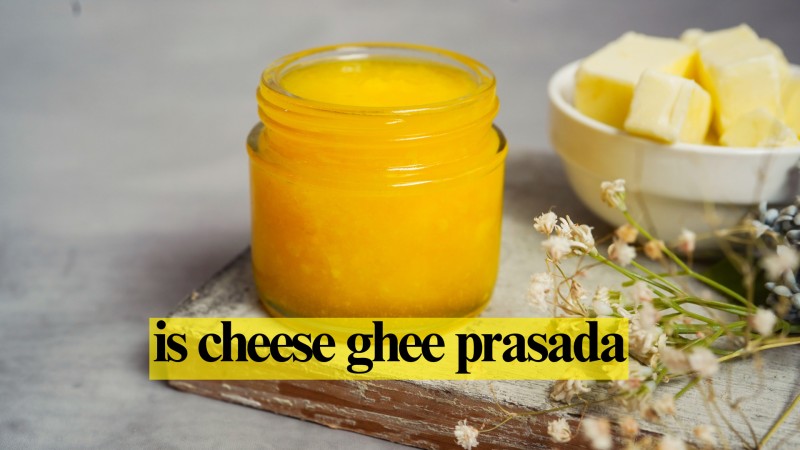Is Cheese Ghee Prasad
In the rich landscape of Indian culture and spirituality, ghee holds a reserved place as a pure and sacred substance, used frequently in rituals and offerings to deities. But what about “cheese ghee,” which is derived from cheese? Is it accepted in the same way? In this article, we will explore what cheese ghee is, why it is traditionally not considered a prasad, and if and how it could potentially be used in worship as a prasad.
what are cheese ghee and traditional ghee?
Traditional ghee is made from butter or cow’s milk, which is then turned into curd. In contrast, cheese ghee is made from cheese. The flavor of cheese ghee varies depending on the type of cheese used, which can result in flavors that are stronger or less neutral than those found in traditional ghee. Additionally, traditional ghee has deep cultural roots in Vedic practices, while cheese ghee lacks significant historical importance and may be viewed as less pure.
Why Traditional Ghee Considered Sacred in Worship
In Hindu and some Buddhist rituals, traditional ghee is cherished as a “Satviik” Food (Pure and spiritually Uplifting). It symbolizes purity, nourishment, and positive energy, Making it an ideal offering for good and goddesses. Traditional ghee is also often used in “arati” Lighting of lamps or diya Yagyah, which are essential in worship. At the same time, cheese isn’t appropriate in worship.
Using ghee as offerings or Prasada sacred food distributed to devotees after worship is believed to carry the blessings of the deity. Traditional ghee is also incorporated in many religious festivals including Holi, Diwali Navaratri, and many festivals in Hindu religions, where sweets are prepared with Ghee.
Can Cheese Ghee Be Used As Prasada?
Cheese ghee, unlike traditional ghee, lacks the same historical and religious standing in sacred rituals. Here are the main reasons why Cheese ghee as a prasada does not fit the criteria for Prasada. Cheese is a fermented product, which is mostly made in factories using ingredients like Salt, Rennet, etc which makes cheese impure for worship or making prasada while Traditional ghee is made with butter which is a pure form and considered satvik.
In ancient scriptures like Vedas and Puranas, there are numerous references to ghee but not to cheese ghee. As a result, chee ghee is less accepted as a prasada in traditional rituals due to its established sanctity. Cheese ghee flavor may vary significantly based on the cheese it’s made from, which can be distracting or even disruptive in rituals where the aroma is an integral element of the offerings.
When Cheese Ghee Might Be Acceptable in Worship.
while traditional practices do not typically include cheese ghee, modern interpretations, or festivals might incorporate it, especially in communities where it is culturally significant. If cheese ghee is the only available ghee, here are a few ways it could be respectfully included.
if using cheese ghee in worship, try to clarify it well so that it resembles traditional ghee as closely as possible in purity and appearance. Limit its use Cheese ghee might be acceptable for lighting lamps or diya for preparing food offerings when traditional ghee is not available. However, it’s best not to use it in central offerings, like main Prasada, Some regional festivals or modern practices may accept cheese ghee as a compromise in areas where access to traditional ghee is limited. In such cases ensure that the cheese ghee used is of high quality.
Using Cheese Ghee in Festive Recipes.
- In non-ritual contexts, cheese ghee could add a unique flavor to sweets and snacks prepared for festivals below are a few ways to include cheese ghee in festive cooking if not for worship or Prasads.
- Sweet cheese ghee might be used in recipes like laddoos, halwa, and burfi to give new twists to traditional sweets.
- Cheese Ghee might also add a savory depth to dishes like namak pare or matri.
- Lighting diya if cheese ghee is of good quality, it can be used to light lamps for Diwali and other festivals.
Is Cheese Ghee Prasada Final Thoughts
While cheese ghee is an interesting alternative to traditional ghee, it is not traditionally considered sacred or pure for making Prasada in Hindu worship. Its connection to fermented ingredients like salt and rennet, and lack of historical reverence make it a less ideal choice. However, in modern adaptation or unique cultural contexts, cheese ghee could find a place in non-cultural offerings or festive cooking, bringing new flavors and traditions.
By understanding the reasons behind the sacred use of traditional ghee, we can respect the nuances of our cultural heritage while also finding ways to incorporate new ingredients with mindfulness, if you’re celebrating with chee ghee, consider using outside the core rituals, and enjoy the richness it adds to your festivals meals.

